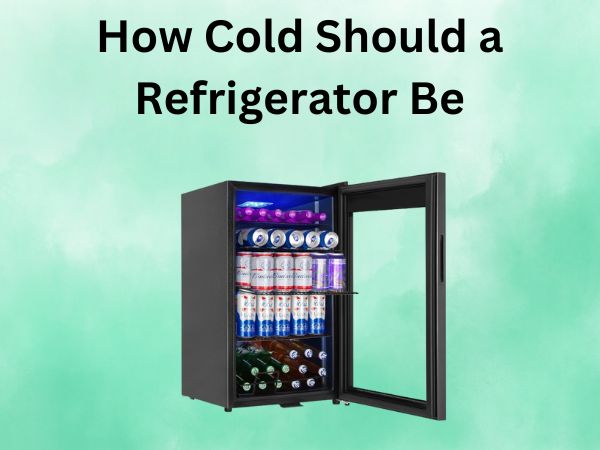How Cold Should a Refrigerator Be [The Ultimate Temperature Guide for Food Safety]
Ever wondered if your refrigerator is doing its job properly? You’re not alone. Getting your fridge temperature just right is like hitting a bullseye – it requires precision, but once you nail it, everything else falls into place. Let’s dive into the world of refrigerator temperatures and discover why this seemingly simple setting can make or break your food safety game.
Table of Contents
Why Refrigerator Temperature Matters More Than You Think
Think of your refrigerator as a guardian standing between you and foodborne illness. It’s not just a cold box – it’s your first line of defense against bacteria that love to party in improperly stored food. But here’s the kicker: most people have no clue what temperature their fridge actually runs at.
The Science Behind Food Preservation
Cold temperatures slow down bacterial growth dramatically. It’s like putting bacteria in slow motion – they’re still there, but they can’t multiply fast enough to cause problems. The magic happens between 32°F and 40°F (0°C to 4°C), where most harmful bacteria become sluggish and struggle to reproduce.
When your refrigerator maintains the right temperature, it creates an environment where food stays fresh longer, nutrients are preserved, and dangerous pathogens can’t establish themselves. Think of it as creating a hostile environment for the bad guys while keeping your food happy and healthy.
Health Risks of Incorrect Temperature
Running your fridge too warm is like rolling the dice with your health. Bacteria like Salmonella, E. coli, and Listeria thrive in temperatures above 40°F. These microscopic troublemakers can turn a simple meal into a trip to the emergency room.
On the flip side, setting your fridge too cold can freeze your fresh produce, turning crisp lettuce into wilted disappointment and making your milk taste off. It’s all about finding that sweet spot where safety meets quality.
The Perfect Refrigerator Temperature: What Experts Recommend
Here’s the golden rule that food safety experts swear by: keep your refrigerator at or below 37°F (3°C). This temperature gives you a comfortable buffer below the danger zone while preventing your food from freezing.
FDA Guidelines for Refrigerator Temperature
The Food and Drug Administration doesn’t mess around when it comes to food safety. They recommend keeping your refrigerator at 40°F (4°C) or below. However, many food safety experts suggest aiming for 35-37°F (2-3°C) to provide an extra margin of safety.
This isn’t just bureaucratic red tape – it’s based on decades of research into bacterial growth patterns and food spoilage. When you follow these guidelines, you’re tapping into the collective wisdom of food scientists who’ve spent their careers keeping us safe.
Different Temperature Zones in Your Fridge
Your refrigerator isn’t a uniform temperature throughout – it’s more like a house with different climate zones. The top shelves tend to be slightly warmer, while the bottom (especially near the back) stays coolest. The door experiences the most temperature fluctuation due to frequent opening.
Understanding these zones helps you store food strategically. Keep your most perishable items in the coldest spots and use the door for condiments and other items that can handle temperature swings.
How to Check Your Refrigerator Temperature Accurately
You can’t manage what you don’t measure. Most refrigerators come with built-in temperature displays, but these can be about as accurate as a weather forecast – sometimes right, sometimes way off.
Using a Refrigerator Thermometer
Investing in a separate refrigerator thermometer is like hiring a personal temperature bodyguard for your food. These inexpensive devices give you the real story about what’s happening inside your fridge.
Place your thermometer in a glass of water and let it sit for several hours before taking a reading. This gives you a more stable and accurate measurement than just hanging the thermometer in open air.
Digital vs. Analog Thermometers
Digital thermometers respond quickly and offer precise readings, making them perfect for the impatient among us. Analog thermometers take longer to adjust but tend to be more reliable over time and don’t need batteries.
Both types work well – choose based on your preference and budget. The important thing is having some way to monitor your actual temperature rather than trusting the often-inaccurate built-in displays.
Where to Place Your Thermometer
The center of your main compartment, away from walls and vents, gives you the most representative reading. Avoid placing it in the door or right next to the cooling vents, as these areas don’t reflect the overall temperature your food experiences.
Common Temperature Problems and Their Solutions
Even the best refrigerators can develop temperature issues. Recognizing these problems early can save you from spoiled food and potential health risks.
Refrigerator Running Too Cold
If your fridge turns into an icebox, you’ll notice frozen lettuce, crystallized milk, and other signs that things have gone too far. This usually means your temperature control is set too low or there’s an issue with the thermostat.
Start by adjusting your temperature setting upward and wait 24 hours before checking again. If the problem persists, you might need professional help to calibrate or replace the temperature control system.
Refrigerator Not Cold Enough
A warm fridge is a dangerous fridge. Signs include spoiled food, unusual odors, and that sinking feeling when you realize your milk went bad two days before the expiration date.
Check for blocked vents, overpacking, or a failing compressor. Sometimes the solution is as simple as cleaning the coils or rearranging items to improve air circulation.
Temperature Fluctuations
If your thermometer readings jump around like a yo-yo, you’ve got circulation or sealing issues. This often happens when door seals are worn, vents are blocked, or the fridge is working overtime due to external factors.
Factors That Affect Your Refrigerator’s Temperature
Your fridge doesn’t operate in a vacuum – various factors influence its ability to maintain consistent temperature.
Door Openings and Heat Transfer
Every time you open that door, you’re essentially inviting the outside world into your carefully controlled environment. Frequent openings, especially for extended periods, force your refrigerator to work harder to maintain temperature.
Minimize door openings by planning what you need before opening, and teach family members to grab everything at once rather than making multiple trips.
Food Placement and Air Circulation
Cramming your fridge full might seem efficient, but it’s like trying to cool a crowded room with poor ventilation. Air needs to circulate freely to maintain consistent temperatures throughout the compartment.
Leave space between items and avoid blocking air vents. Think of it as creating highways for cold air to travel throughout your fridge.
Seasonal Changes and External Temperature
Your refrigerator works harder in summer when ambient temperatures rise. If your fridge is in a garage or basement where temperatures fluctuate significantly, you might need to adjust settings seasonally.
Optimal Storage Temperatures for Different Foods
Not all foods have the same temperature needs. Understanding these differences helps you make the most of your refrigerator’s various zones.
Dairy Products and Eggs
Milk, cheese, and eggs perform best in the coldest part of your main compartment – usually the bottom shelf toward the back. These protein-rich foods are particularly susceptible to bacterial growth and benefit from consistently cold storage.
Meat and Poultry
Raw meat and poultry should live in the coldest spot possible, ideally in a dedicated meat drawer if your fridge has one. This minimizes bacterial growth and prevents cross-contamination with other foods.
Fruits and Vegetables
Most produce prefers slightly higher humidity and temperatures around 32-35°F. Crisper drawers are designed to provide these conditions, but not all fruits and vegetables belong there – some actually prefer room temperature storage.
Leftovers and Prepared Foods
Cooked foods should be cooled quickly and stored in the main compartment where temperatures are most consistent. Don’t leave them lingering in the door where temperature swings can accelerate spoilage.
Energy Efficiency and Temperature Settings
Finding the balance between food safety and energy efficiency is like walking a tightrope – it requires careful attention but pays off in the long run.
Finding the Balance Between Safety and Savings
Every degree you lower your refrigerator temperature increases energy consumption by about 5%. However, the cost of replacing spoiled food and potential medical bills from foodborne illness far outweigh the energy savings from running a warmer fridge.
Stick to the recommended temperature range and look for energy savings through better maintenance and usage habits instead.
Modern Refrigerator Features
Today’s refrigerators come with smart features like precise temperature controls, multiple climate zones, and even smartphone connectivity. These features can help you maintain optimal temperatures while maximizing efficiency.
Signs Your Refrigerator Temperature Needs Adjustment
Your fridge communicates with you – you just need to know what to look for.
Food Spoilage Indicators
If food consistently spoils before its expiration date, your fridge might be running too warm. On the other hand, if fresh produce freezes or milk develops an off taste, you’re probably running too cold.
Ice Formation Problems
Excessive frost buildup or ice formation on food packages usually indicates temperature control issues or poor air circulation. Address these problems promptly to prevent bigger issues down the road.
Maintaining Consistent Temperature Year-Round
Consistency is key when it comes to refrigerator temperature. Small adjustments and regular maintenance keep everything running smoothly.
Seasonal Adjustments
You might need to tweak your temperature settings when seasons change, especially if your refrigerator is in an unconditioned space. Monitor temperatures closely during extreme weather periods.
Regular Maintenance Tips
Clean condenser coils quarterly, check door seals annually, and replace water filters as recommended. These simple maintenance tasks help your refrigerator maintain consistent temperatures efficiently.
Frequently Asked Questions
1. What happens if my refrigerator is set to 32°F? While 32°F won’t harm food safety, it’s at the freezing point and may cause some fresh foods to develop ice crystals or change texture. Most foods perform better at 35-37°F where they stay fresh without freezing.
2. How often should I check my refrigerator temperature? Check your thermometer weekly and immediately after any power outages or if you notice food spoiling faster than usual. It’s also wise to check when seasons change or after heavy usage periods.
3. Can I use my smartphone to monitor refrigerator temperature? Some modern smart refrigerators offer app-based temperature monitoring, and you can purchase separate smart thermometers that send alerts to your phone. These can be particularly useful for catching problems early.
4. Why does my refrigerator temperature fluctuate throughout the day? Normal fluctuations of 1-2 degrees are expected due to door openings, defrost cycles, and varying food loads. However, larger swings may indicate maintenance issues or poor door seals.
5. Is it safe to eat food if my refrigerator was too warm overnight? This depends on how warm it got and for how long. If temperatures exceeded 40°F for more than 2 hours, perishable foods like meat, dairy, and leftovers should be discarded. When in doubt, throw it out – it’s not worth the risk
Conclusion
Getting your refrigerator temperature right isn’t rocket science, but it does require attention to detail. Aim for 35-37°F (2-3°C) for optimal food safety and quality, use a separate thermometer to verify your actual temperature, and adjust as needed based on your specific circumstances.
Remember, your refrigerator is working 24/7 to keep your food safe and fresh. Give it the attention it deserves, and it’ll reward you with longer-lasting food, better flavors, and peace of mind knowing you’re protecting your family’s health.
.





